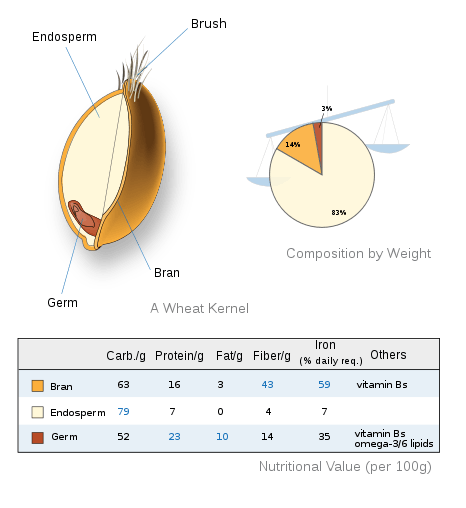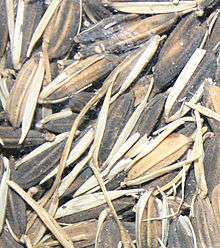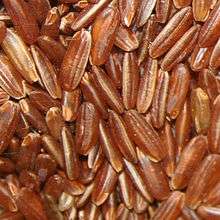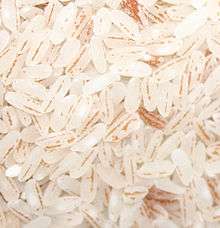Whole grain

A whole grain is a cereal grain that contains the germ, endosperm, and bran, in contrast to refined grains, which retain only the endosperm.
Varieties
Common whole grains include:
- Wheat (e.g. farro and Kamut)
- Oat
- Barley (hulled and dehulled but not pearl)
- Maize
- Brown rice
- Rye
- Millet
- Quinoa
- Amaranth
- Triticale
- Teff
- Buckwheat
Common refined wholegrain products include:
- Whole wheat flour
- Whole wheat bread
- Whole wheat pasta
- Rolled oats or oat groats
- Triticale flour
- Popcorn
- Teff flour
Common refined non-wholegrain products include:
- White rice
- White flour
- White bread
- Hominy
- Pasta (non-whole wheat varieties)
 African rice in its inedible husk (seed rice, will sprout) |
 The same rice, dehusked (whole grain rice, colour varies by variety) |
 The same rice, with almost all bran and germ removed to make white rice |
Health effects
Consumption of whole grains has been linked with a decrease in cardiovascular disease, cancer, and death.[1] Regular whole-grain consumption lowers LDL and triglyceride levels, which contributes to an overall 26% reduction in coronary heart disease-risk factors. In addition, whole-grain consumption is inversely related to hypertension, diabetes, and obesity when compared to refined grains, all of which are negative indicators in total cardiovascular health.[2][3]
Keeping grains as close to their original form as possible slows or prevents the digestion of starch, and a slower digestion is responsible for preventing spikes in blood sugar (over time spikes in blood sugar may lead to insulin resistance).[4]
Regulations
Wholegrain products can be identified by the ingredients list. "Wheat flour" (as opposed to "wholegrain wheat flour" or "whole-wheat flour") as the first ingredient is not a clear indicator of the product's wholegrain content. If two ingredients are listed as grain products but only the second is listed as wholegrain, the entire product may contain between 1% and 49% wholegrain.[5] Many breads are colored brown (often with molasses or caramel color) and made to look like wholegrain when they are not. In addition, some food manufacturers make foods with wholegrain ingredients, but, because wholegrain ingredients are not the dominant ingredient, they are not wholegrain products. Contrary to popular belief, wholegrains are not indicative of fiber. The amount of fiber varies from grain to grain, and some products may have things like bran, peas, or other foods added to boost the fiber content.[6]
In Canada, it is legal to advertise any food product as "whole wheat" with up to 70% of the germ removed.[7] While the resulting product will contain the benefit of fiber in the nutritional information, it lacks the nutritional content found in the wheat germ. Canadian consumers can be assured of whole-grain products by a label stating 100% whole-grain whole wheat.
Similar to the distinction between whole and refined grains is that between whole pulses (peas, beans, and other related vegetables) and refined dal (a preparation of pulses or the thick stew prepared from these).
From AACC (American Association of Cereal Chemists) definition: "Whole grains shall consist of the intact, ground, cracked or flaked caryopsis, whose principal anatomical components - the starchy endosperm, germ and bran - are present in the same relative proportions as they exist in the intact caryopsis."
U.S. standards of identity
The following names indicate whole-grain products, in accordance with the federal government:[8][9][10]
- "Whole wheat bread"
- "Whole millet"
- "Whole wheat buns"
- "Whole wheat macaroni"
- "Whole wheat spaghetti"
- "Whole wheat vermicelli"
- "Cracked wheat" (as an ingredient, not part of a name, as in "cracked wheat bread")
- "Crushed wheat"
- "Whole wheat flour"
- "Graham flour" (as an ingredient, not as part of a name as in "graham crackers")
- "Entire wheat flour"
- "Bromated whole wheat flour"
- "Whole durum flour"
- "Bulgur (cracked wheat)" (note that "bulgur" by itself may or may not indicate whole grain)
Canadian standards of identity
There are multiple grains such as cereal grains (e.g. wheat, rice, oats, barley, corn, wild rice, and rye) as well as pseudocereals (e.g. quinoa and buckwheat) that may be labeled whole grains.[11]
When wheat is milled to make flour, the parts of the grain are usually separated and then are recombined to make specific types of flour, such as whole wheat, whole grain, white cake and pastry flour, and all-purpose white flour. If all parts of the kernel are used in the same relative proportions as they exist in the original kernel, then the flour is considered whole grain.
Under the Food and Drug Regulations, up to 5% of the kernel can be removed to help reduce rancidity and prolong the shelf life of whole-wheat flour. The portion of the kernel that is removed for this purpose contains much of the germ and some of the bran. If this portion of the kernel has been removed, the flour would no longer be considered whole grain.
See also
References
- ↑ Aune, Dagfinn; Keum, NaNa; Giovannucci, Edward; Fadnes, Lars T; Boffetta, Paolo; Greenwood, Darren C; Tonstad, Serena; Vatten, Lars J; Riboli, Elio; Norat, Teresa (14 June 2016). "Whole grain consumption and risk of cardiovascular disease, cancer, and all cause and cause specific mortality: systematic review and dose-response meta-analysis of prospective studies". BMJ: i2716. doi:10.1136/bmj.i2716.
- ↑ Anderson, JW; Hanna, TJ; Peng, X; Kryscio, RJ (June 2000). "Whole Grain Foods and Heart Disease Risk". Journal of the American College of Nutrition. 19 (3 Suppl): 291S−299S. PMID 10875600.
- ↑ de Munter, Jeroen S. L.; Hu, Frank B.; Spiegelman, Donna; Franz, Mary; van Dam, Rob M. (2007-08-01). "Whole grain, bran, and germ intake and risk of type 2 diabetes: a prospective cohort study and systematic review". PLoS medicine. 4 (8): e261. doi:10.1371/journal.pmed.0040261. ISSN 1549-1676. PMC 1952203
 . PMID 17760498.
. PMID 17760498. 
- ↑ "Glycemic Index – From Research to Nutrition Recommendations?" (PDF). Retrieved 2007-07-09.
- ↑ "Whole Grains Council - Intro to Whole Grains". Retrieved 2007-10-10.
- ↑ "Whole Grains Council - Identifying Whole Grain Products". Retrieved 2008-02-10.
- ↑ Schwartz, Rosie. "A wholegrain of truth". Retrieved 2007-05-01.
- ↑ "21 CFR 136". Archived from the original on 2007-12-21. Retrieved 2008-02-10.
- ↑ "21 CFR 137". Archived from the original on 2007-11-02. Retrieved 2008-02-10.
- ↑ "21 CFR 139". Archived from the original on 2007-11-02. Retrieved 2008-02-10.
- ↑ "Whole Grains - Get the Facts". hc-sc.gc.ca. Retrieved 17 May 2015.
External links
- Article from BBC news
- Definition of Whole Grain
- Tips For Preventing Insulin Resistance
- U.S. FDA Guidance on Whole Grain Label Statements (Draft)

